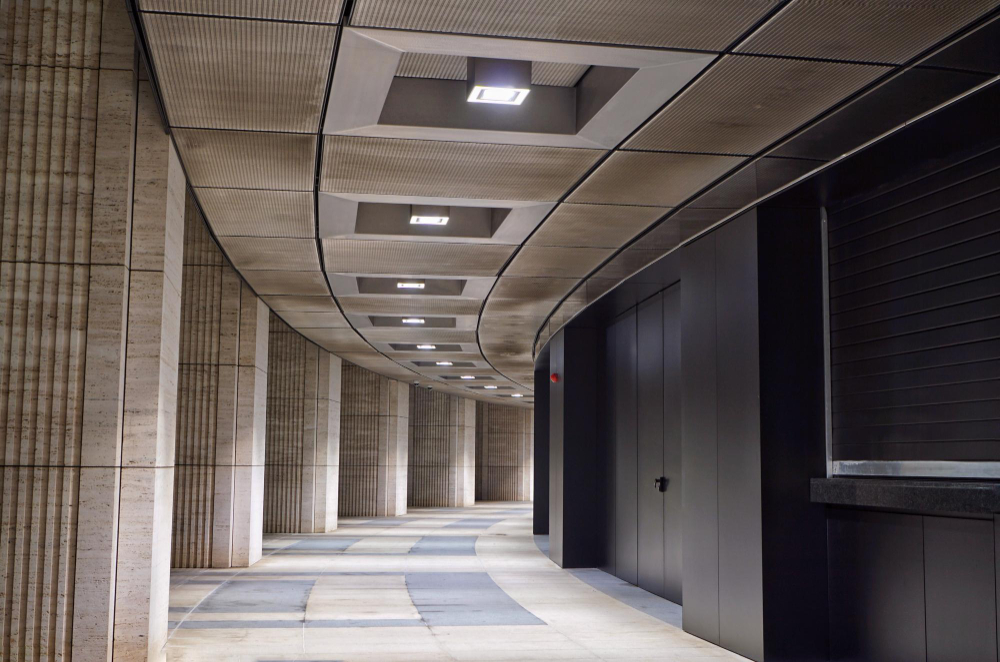The way we perceive a space is frequently shaped by its acoustics. An impressive architectural design may lose its allure if the acoustics are lacking, conversations reverberate, machinery buzzes excessively, or music becomes muddled throughout the space. Conversely, a thoughtfully curated acoustic setting exudes tranquility, fosters productivity, and promotes a sense of harmony.
Sound absorption, which was once a specialized technical aspect, has now emerged as a key element in contemporary architecture and interior design. From lively workplaces and collaborative educational environments to inviting residences and artistic spaces, designers are adopting cutting-edge materials and techniques to create areas that are as acoustically pleasing as they are visually appealing.
Let’s delve into the newest developments in sound absorption, a fascinating intersection of design, innovation, and eco-friendliness.
The Importance of Sound Absorption in Modern Architecture
Why Acoustics Matter More Than Ever
Sound shapes the ambiance. In architectural design, the influence of acoustics plays a crucial role in shaping how individuals engage with their surroundings. Subpar acoustics can result in overwhelming echoes, prolonged reverberation, and intrusive noise, all of which diminish both comfort and productivity.
Picture yourself in a shared workspace where every phone conversation echoes throughout the area, or dining at a restaurant where engaging in dialogue feels like a struggle against the surrounding noise. These are not merely trivial irritations; they significantly affect overall well- being and cognitive function.
A 2023 report from the International Well Building Institute reveals that indoor noise levels exceeding 55 decibels can diminish workplace productivity by as much as 30%. Sound control is essential in architectural planning, transforming it from a mere luxury into a fundamental requirement.
The Impact on Everyday Living
The impact of acoustics extends beyond just offices; it also influences homes, schools, and healthcare settings. A serene and harmonious auditory landscape promotes tranquility, concentration, and restorative processes.
Consider your living room — a space designed for unwinding. In the absence of effective sound absorption, each footstep, dialogue, or clinking glass resonates off hard surfaces, resulting in an unsettling echo. Effective acoustic design transforms these areas into havens of tranquility. A study released by The Acoustic Society of America (2024) reveals that individuals living in sound-optimized homes experience a 40% increase in comfort satisfaction when compared to those in acoustically untreated settings.
That’s why companies like Acosorb are leading the way in creating acoustic solutions that seamlessly combine technical excellence with aesthetic appeal, making every environment as tranquil as it appears.
Innovative Materials for Sound Absorption
Sustainable and Eco-Friendly Solutions
The evolution of sustainability is influencing all aspects of design, including the realm of acoustics. Conventional foam and fiberglass panels are giving way to innovative materials that prioritize renewability, biodegradability, and environmental safety.
Architects are increasingly utilizing materials like recycled cotton, bamboo fibers, cork, hemp, and even repurposed PET bottles to create high-performance acoustic systems. These materials not only lessen environmental impact but frequently surpass older synthetic alternatives when it comes to sound dampening and breathability.
Research from the Green Building Council (2023) indicates that sustainable acoustic materials can absorb as much as 85% of sound energy in mid-frequency ranges, matching the performance of traditional fiberglass panels while significantly reducing the carbon footprint.
In addition to their sustainable qualities, these materials possess a certain visual charm that is hard to overlook. They can be molded, colored, or finished to complement any design scheme, providing architects with enhanced creative flexibility.
Design-Driven Acoustic Panels
The era of acoustic panels being merely utilitarian — dull, gray, and tucked away from sight — is behind us. Contemporary interior acoustics blend aesthetics and practicality effortlessly.
Modern panels showcase unique prints, geometric patterns, and artistic shapes that function beautifully while enhancing the aesthetic appeal. These are perfectly suited for workplaces, dining establishments, and cultural venues that value atmosphere alongside functionality. Companies such as Acosorb have embraced this design approach, creating acoustic solutions that transform entire walls or ceilings into visually captivating installations, all while ensuring excellent sound absorption performance.
Technologies Behind Modern Sound Insulation

Micro-Perforated and Resonant Systems
Recent developments in material science have led to the creation of micro-perforated panels (MPP) — sheets featuring minuscule holes that effectively scatter and absorb sound waves, eliminating the need for conventional fibrous insulation.
MPP technology utilizes acoustic resonance; as sound waves penetrate the micro-holes, friction and air resistance transform them into heat energy, efficiently eliminating unwanted noise. This enables elegant, streamlined surfaces while maintaining excellent sound quality.
These systems prove to be especially beneficial in venues like performance halls, airports, and museums, where the visual appeal is just as crucial as the quality of sound.
A study from the 2024 Acoustical Engineering Review revealed that MPPs can decrease reverberation time by as much as 40% in comparison to conventional paneling, marking a significant advancement for contemporary design initiatives.
Smart Acoustic Control Systems
As home technologies advance, sound environments are becoming more responsive and automated. Nowadays, advanced sound systems have the capability to assess surrounding noise instantly and modify their settings to ensure a superior auditory experience.
For example, sensors can identify when an area becomes excessively noisy and discreetly modify the acoustics — by engaging concealed dampening systems or altering dynamic materials that change their density and porosity.
These advancements are especially significant in conference rooms, classrooms, and versatile spaces, where acoustic conditions fluctuate throughout the day.
As noted in Smart Building Journal (2024), advanced acoustic systems can enhance speech clarity by 35% and simultaneously lower energy consumption by decreasing reliance on mechanical noise control devices.
Applying Acoustic Innovation Across Environments
Open Office Spaces
Open-plan offices have transformed contemporary work environments, yet they have also brought forth new challenges in acoustics. The incessant chatter, persistent ringing, and the rhythmic tapping of keyboards contribute to a cacophony that saps concentration.
Creative approaches to sound absorption can transform the situation. Through the thoughtful arrangement of ceiling baffles, acoustic dividers, and wall panels, designers can establish serene areas while maintaining team cohesion.
A recent study from Harvard Business Review highlighted that workers in acoustically optimized offices experience 28% greater concentration and 18% reduced stress compared to those in untreated open environments.
Acoustic design transcends mere comfort; it plays a crucial role in enhancing performance, fostering collaboration, and promoting employee well-being.
Home Workspaces and Residential Design
The shift to remote work has reshaped our perception of auditory comfort in our living spaces. In the midst of online meetings, children's activities, and the hustle and bustle of city life, achieving acoustic harmony has become an essential element of interior design.
Acoustic wall panels, ceiling tiles, and soft furnishings can significantly minimize reverberation and ambient echo. Materials such as cork, felt, and wool composites offer a blend of beauty and practicality, providing homeowners with a cozy and chic approach to crafting serene spaces.
Certain homeowners opt for acoustic plaster systems that integrate effortlessly with ceilings and walls, delivering discreet sound absorption. These are becoming more sought after in upscale residences and streamlined designs.
Innovators like Acosorb show that incorporating acoustics from the very beginning of the design process leads to superior results, rather than addressing noise issues later on.
Hospitality, Education, and Healthcare Environments

In the realm of education, effective communication enhances understanding and memory retention. In healthcare settings, quiet surroundings facilitate quicker patient healing and reduce anxiety levels. In the realm of hospitality, sound plays a crucial role in shaping atmosphere and connection — ranging from the gentle whisper of an upscale dining establishment to the lively buzz of a hotel lobby bar.
Contemporary architects are increasingly adopting zone-based acoustic planning, integrating a variety of materials, sound mapping techniques, and customizable dampening zones designed for specific functions. This intricate approach illustrates the evolution of human-centric design, harmonizing beauty with emotional health.
Personalized and Custom Acoustic Solutions
Each space possesses its own distinct character, varying in dimensions, function, and the way individuals interact within it. That’s why generic sound solutions seldom prove effective.
Custom acoustic design entails examining factors such as:
- Room geometry and surface reflectivity
- Occupancy density and activity levels
- Source of sound and listener positions
By employing acoustic simulation tools, designers gain the ability to visualize sound dynamics within a specific environment and adjust materials to enhance auditory experiences.
For instance, an art gallery might benefit from reflective surfaces that maintain vibrancy, whereas a library necessitates substantial absorption to reduce distractions. Tailored solutions guarantee that these requirements are addressed with precision.
As noted in the Architectural Acoustics Review (2023), environments that implement customized acoustic strategies can attain comfort ratings that are up to 50% greater than those with standard setups.
Integrating Acoustics with Aesthetic Vision
Acoustic design goes beyond just technical performance; it encompasses the essence of visual identity as well. The most effective solutions integrate effortlessly with the design aesthetic of the environment.
Architects are currently exploring parametric design, utilizing computational modeling to create acoustic panels that feature visually striking organic patterns, all while enhancing sound diffusion. These can elevate ceilings or walls into striking art forms that also fulfill a functional role.
A wave-like baffle ceiling in a concert hall serves the dual purpose of evenly dispersing sound while simultaneously elevating the visual appeal of the space. In a similar vein, textured acoustic walls can serve as striking décor elements in contemporary residences and workplaces.
This blend of aesthetics and functionality reflects the core beliefs of companies such as Acosorb, whose offerings demonstrate that acoustic design can be both expressive and practical.
The Future of Sound Absorption in Architecture
As we move forward, advancements in acoustics will become more closely linked with digital technology, sustainability, and the overall well-being of individuals. Future materials are expected to be biophilic, adaptive, and self-healing, emulating natural mechanisms such as tree bark or coral surfaces to dynamically absorb and scatter sound.
Utilizing AI for acoustic modeling will significantly enhance the ability of architects to anticipate sound dynamics in intricate designs well ahead of the actual construction phase. This forward- thinking design strategy minimizes rework, cuts costs, and lessens environmental impact.
Additionally, innovative hybrid materials that combine sound absorption, air purification, and thermal insulation are currently being developed, providing a multifunctional approach in a single sustainable solution.
The intersection of design, science, and sustainability will guarantee that sound absorption evolves from a mere technical necessity to a hallmark of future architectural endeavors.
Final Thoughts
Sound absorption transcends mere noise control; it plays a crucial role in crafting experiences, boosting comfort, and elevating the environments in which we reside, engage, and interact. With the use of sustainable materials and advanced acoustic technologies, innovation is continually reshaping the relationship between architecture and sound.
Through the early incorporation of careful acoustic planning in the design process, architects and designers have the ability to elevate standard spaces into remarkable environments that foster concentration, tranquility, and a sense of community.
For creative ideas, design perspectives, and top-notch acoustic solutions, check out https://www.acosorb.com/ — the intersection of sound, style, and sustainability.



